If you’re curious about Semrush and how it can boost your online marketing efforts, you’re in the right place. I’ve been using Semrush for years, and I’m excited to share the key features that make it indispensable for SEO professionals and digital marketers alike.
Search engine optimization is crucial for building a lasting, successful online presence. But let’s be honest – SEO is complex. It involves in-depth keyword research, technical site audits, and crafting effective link-building strategies. The sheer scope of work can be overwhelming.
You might be wondering if it’s even possible for one person to handle all these tasks effectively. The short answer is no, it’s not – at least not without help. That’s where SEO tools come in. A high-quality SEO tool can dramatically improve your search rankings in a relatively short time.
Semrush stands out as one of the most user-friendly and cost-effective SEO tools available today. I’ve found it to be an invaluable asset in my own SEO work.
SEMrush is a fantastic all-in-one SEO tool made up of over 50 different tools that will boost your SEO, content marketing, keyword research, PPC, and social media marketing campaigns.
You can use it to carry out keyword research, and keyword rank tracking of your website, and of your competitors. You can also use it to do technical SEO audits, content audits, search for backlink opportunities, track everything through reports, and so much more.
SEMrush is well-known and highly trusted by SEO professionals and digital marketers everywhere.
- Best all-in-one marketing and SEO tool in 2025.
- A LOT of value for money.
- A must-have tool for anyone looking to improve their online marketing efforts and achieve better results.
- Not free - not cheap.
- The user interface takes time to get used to, is overwhelming and confusing.
- Only provides data from Google.
TL;DR: SEO tools are essential assets if you’d like to build a long-term, sustainable, and successful business. One of the best tools you can find on the market these days is Semrush. In this article, I’ll look at its main features, functionalities, and subscription plans.
What is Semrush and How Does It Work?
Founded in 2008 in Boston, Semrush’s main job is to optimize your website for all sorts of search engines entirely. Nowadays, Semrush is the number one choice of dozens of internationally famous multibillionaire companies, such as Amazon, Samsung, Forbes, Apple, etc.
Used by more than 10 million users worldwide, Semrush helps you expand your company or business with the help of more than 500 online tools for content marketing, SEO, competitor research, social media marketing, and pay-per-click (PPC).
As you can see for yourself, Semrush is not an SEO tool only; it offers a lot more than SEO features and services!
Let’s take a look at Semrush’s essential features, services, functionalities, and subscription plans. We’ll start by explaining Semrush’s main features and why website owners use it.
What Is Semrush Used For?
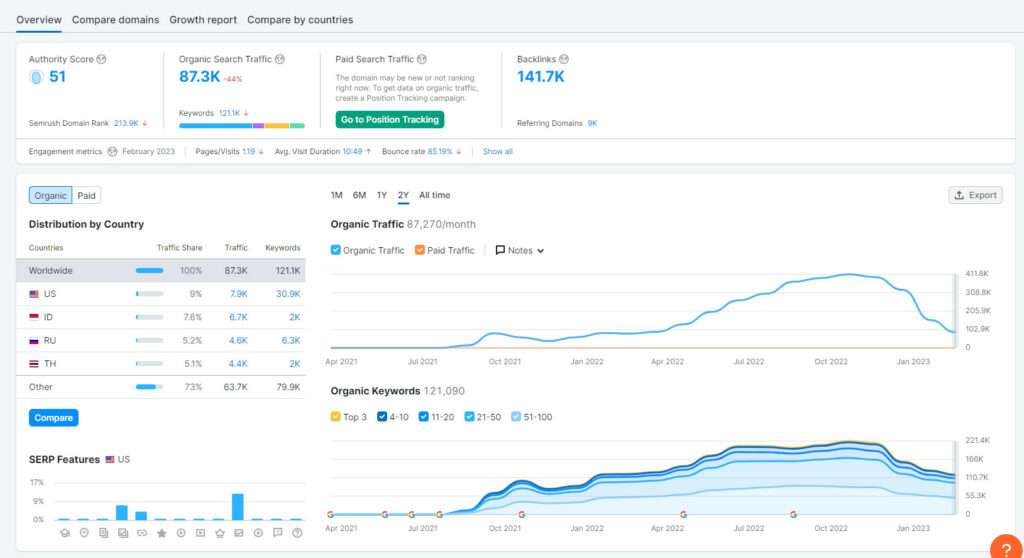

Semrush offers several essential features that can make a complete difference in how your business will continue to grow. Let’s see why website owners use Semrush:
- SEO: It helps you grow organic website traffic, discover profitable and non-profitable keywords, analyze the backlink profile on any domain, conduct SEO audits, and track SERP positions.
- Content marketing: It helps you create content that can be ranked, discover topics suitable for your target audience, find out how to create content that is 100% SEO friendly, track how many times your brand has been mentioned and its overall reach, and audit your content with the help of real-time key performance indicators.
- Agency tools: It lets you streamline your business, collect data insights, discover marketing opportunities, automate reports by clients, and manages your overall workflow in customer relationship management
- Social media: It lets you create a suitable social media strategy for the needs of your company, lets you schedule when you’ll post social media content, evaluates and monitors your posts’ reach and overall performance, monitors and evaluates the social media accounts of your competitors, and lets you optimize and create social media ads.
- Market research: It discovers the marketing strategies of your competitors, helps you analyze website traffic, discovers promotion approaches of your competitors, discovers backlinks or keyword breaches, and helps you grow your company’s website market share.
- Advertising: Semrush finds ways to gain more reach without spending a lot of your funds, find suitable keywords for your website’s pay-per-click strategy, optimize and analyze your ad campaigns by Google Shopping, detect the landing pages and ads of your competitors, etc.
Is Semrush Free?
Right now, you cannot use Semrush for free for an unlimited period.
However, there’s a free trial that lasts FOURTEEN days that might help you find out whether you’d like to subscribe to a monthly plan or not. All you have to do is create an account and sign up for a free trial.
How Much Is Semrush Per Month?
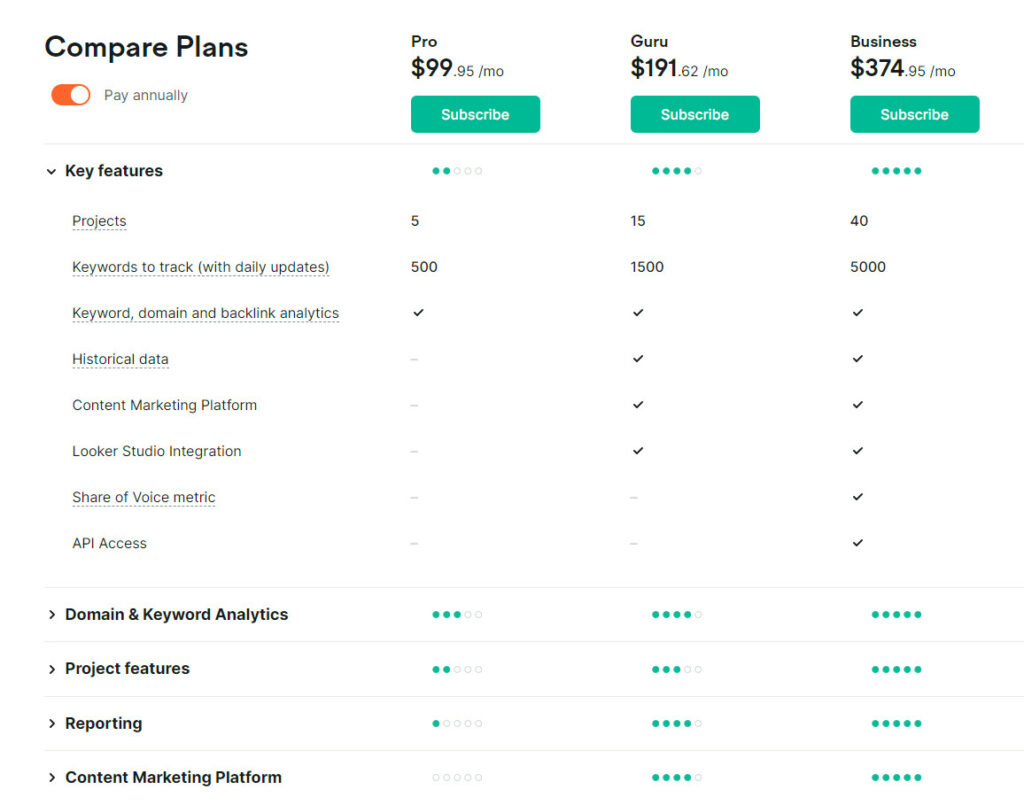
Semrush offers three subscription plans:
- Pro: $119.95 per month (or $99.95 when paid annually). With Pro, you can use Semrush on five projects, 500 keywords that can be tracked, and 10.000 results for each report.
- Guru: $229.95 per month (or $191.62 when paid annually). With Guru, you can use Semrush on 15 projects, 1500 keywords that can be tracked, and 30.000 results for each report.
- Business: $449.95 per month (or $374.95 when paid annually). With Business, you can use Semrush on 40 projects, 5000 keywords that can be tracked, and 50.000 results for each report.
You can only use Pro or Guru for free for 14- days and ask for a customized pricing offer for the Business plan.
If you’re interested in the subscription limits and differences between the subscription plans, read Semrush’s analysis here.
| Plan | Monthly price | Free trial | Projects | Keywords |
| Pro | $119.95 ($99.95 when paid annually) | 14-day free trial | Up to 5 | 500 |
| Guru | $229.95 ($191.62 when paid annually) | 14-day free trial | Up to 15 | 1500 |
| Business | $449.95 ($374.95 when paid annually) | No | Up to 40 | 5000 |
Should I Use Semrush Pro or Guru?
The Pro plan is perfect for smaller companies, freelancers, bloggers, and in-house SEO and internet marketers. On the other hand, the Guru plan is a more suitable choice for SEO consultants, agencies with a vast number of clients, or mid-sized businesses.
Also, let’s not forget the Business plan — the ideal solution for large companies or enterprises.
Before settling for one of these plans, you might want to look at the features you’ll get with Pro and Guru. With Pro, you’ll get the following:
- SEO, pay-per-click (PPC), and social media tools
- Analysis of your competitors
- In-depth keyword research
- Advertising tools
- Website auditing
- Etc.
In addition to the Pro features, Guru offers:
- A toolkit for content marketing
- Data history
- Device and location tracking
- Integration with Google’s Looker Studio (previously called Google DataStudio)
- Etc.
Semrush Alternatives and Competitors
Before subscribing to any pricing plans offered by Semrush, you might want to consider reading more about the features and services provided by similar SEO tools.
We’ve reviewed the main differences between Semrush and four alternative SEO tools to help you understand what each offers.
Semrush vs Ahrefs
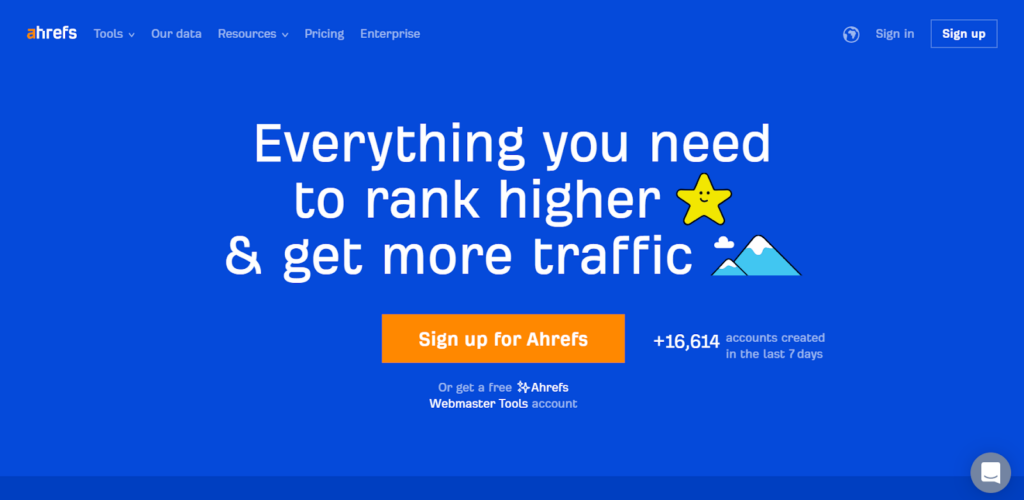
Just like Semrush, Ahrefs is a high-ranking multifunctional SEO tool that worldwide leading marketers use, such as Adobe, Shopify, LinkedIn, eBay, Uber, TripAdvisor, and many more.
In addition to being an excellent choice for large companies and enterprises, it’s also a suitable SEO tool for solo bloggers, SEO marketers, and small-sized companies or startups.
| Tool | Prices start at | Free trial | Refund | Best for |
| Semrush (Pro plan) | $99.95 per month | 14-day free trial | 7-day money-back guarantee | Additional tools: social media, content research, marketing, etc. |
| Ahrefs (Lite plan) | $99 per month | 2 months for free after subscribing to an annual plan | No | SERP tracking — up to 750 words |
What Does Ahrefs Do Better?
Ahrefs offers similar features to Semrush, such as competitors’ analysis, site audit, content and keywords explorer, rank tracker, etc. However, there are several things offered by Ahrefs that Semrush does not offer:
- Search crawlers: Ahrefs collects data from its search crawlers through its own independent database. Then, it sources the data from various online platforms. On the other hand, Semrush collects data only from Google searches.
- Verifying website ownership: If you verify that you are the owner of a specific domain, you can use Ahrefs’ features on an unlimited number of websites.
- Affordable plans: Compared to Semrush, Ahrefs offers more affordable subscription plans. Ahrefs’ pricing plans start at $99 per month (however, this is their very limited Lite plan), and Semrush’s Pro plan starts at $99.95 per month. What’s more, if you pay annually, you’ll get to use Ahrefs for free for two months.
- Free access: If you’re a certified website owner, you can get limited access to Site Audit and Site Explorer for free by signing up for Ahrefs Webmaster Tools.
SERP tracking: Ahrefs lets you track (SERP position tracking) up to 750 keywords with its most affordable plan, and Semrush lets you track up to 500 keywords with its entry-level plan.
What Does Semrush Do Better Than Ahrefs?
Now, let’s learn more about the main advantages of Semrush compared to Ahrefs:
- Social media marketing tools: Semrush offers social media marketing tools, and Ahrefs doesn’t. For example, Semrush has a dashboard where you can gain an in-depth analysis of all kinds of activities on various social media platforms related to your competitors’ websites and your business. You can also learn more about your posts’ reach and the percentage of engagements and followers gained after you’ve posted something.
- Keyword Magic Tool: Unlike Ahrefs, this very popular SEO tool from Semrush gives you access to a database of over 20 billion unique keywords.
- Daily and monthly reports: With Semrush, you can pull many more reports on a daily and monthly basis compared to Ahrefs. Even if you subscribe to the most affordable plan, you can still get 3000 domain reports. On the other hand, with Ahrefs, you can get up to 500 reports monthly, which is a lot less.
- Cancellation and refund policy: Semrush has a cancellation and refund policy. If you cancel your subscription and ask to get your money back within seven days, you’ll get them back. Unlike Semrush, Ahrefs doesn’t offer refunds. You can ask for a refund if you’ve subscribed to a monthly plan and never used any features, but there’s no 100% guarantee your request will be accepted.
- Customer support: Semrush offers more ways to support its customers. You can contact Semrush via chat, e-mail, and phone customer support. On the other hand, Ahrefs offers chat and e-mail support.
Semrush vs Moz
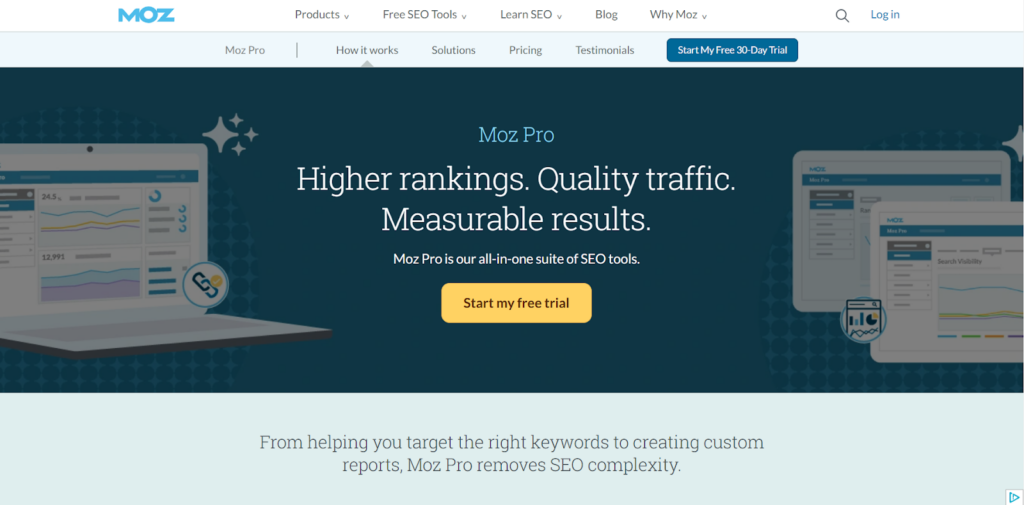
Founded in 2004, Moz is a Seattle-based SEO software development company that offers various SEO tools, helps you track your website’s keyword ranking, improve your website’s organic traffic, audit, crawl, and optimize your website, discover brand-new linking possibilities, create SEO-friendly content, etc.
| Tool | Prices start at | Free trial | Refund | Best for |
| Semrush (Pro plan) | $99.95 per month | 14-day free trial | 7-day money-back guarantee | Additional tools: social media, content research, marketing, etc. |
| Moz (Pro plan) | $99 per month | 30-day free trial | No | Monthly crawl limits, data ranking |
What Does Moz Do Better?
Although quite similar to Semrush, there are a few features and services that Moz provides and Semrush doesn’t:
- Monthly crawl limits: Moz offers more crawl limits on a monthly basis compared to Semrush. You can crawl up to 3000 pages with this tool.
- Tool for link intersection: With Moz’s tool for link intersection, you can compare and contrast one domain with five other domains. With Semrush, you can compare a domain with four domains.
- Free trial: Moz has a more extended free trial than Semrush. You can use it for free for 30 days before deciding whether you’d like to subscribe to one of its plans.
- Ranking data from various web browsers: Moz provides ranking data from search results from various web browsers, such as Google, Yahoo, and Bing. Semrush’s data is limited only to search results provided by Google.
- Affordable plans: Compared to Semrush, Moz offers more affordable subscription plans. Moz’s Pro pricing plans start at $99 per month, and Semrush’s Pro starts at $99.95 per month.
What Does Semrush Do Better Than Moz?
Let’s see what the main advantages of Semrush are compared to Moz:
- User-friendly interface: Semrush has a straightforward and easy-to-use interface design. Even if you’ve never used an SEO tool, you’ll learn how to master it much easier than Moz.
- An easy-to-use Site Audit tool: Semrush’s Site Audit tool is much easier to use than Moz.
- PPC data: Unlike Moz, Semrush collects data connected to pay-per-click (PPC), not just SEO.
- Customer support: Moz only has e-mail customer support. On the other hand, Semrush offers more ways to support its customers. You can contact Semrush via chat, e-mail, and phone customer support.
- Daily reports: You can pull a larger percentage of daily domain analysis or keyword reports with Semrush (up to 3000). With Moz, you can get up to 150 keyword reports monthly if you’re subscribed to the starter plan and 5000 backlink reports on a monthly basis.
- Refund: Semrush offers a 7-day money-back guarantee. On the other hand, Moz doesn’t offer any kind of refund.
Semrush vs SimilarWeb
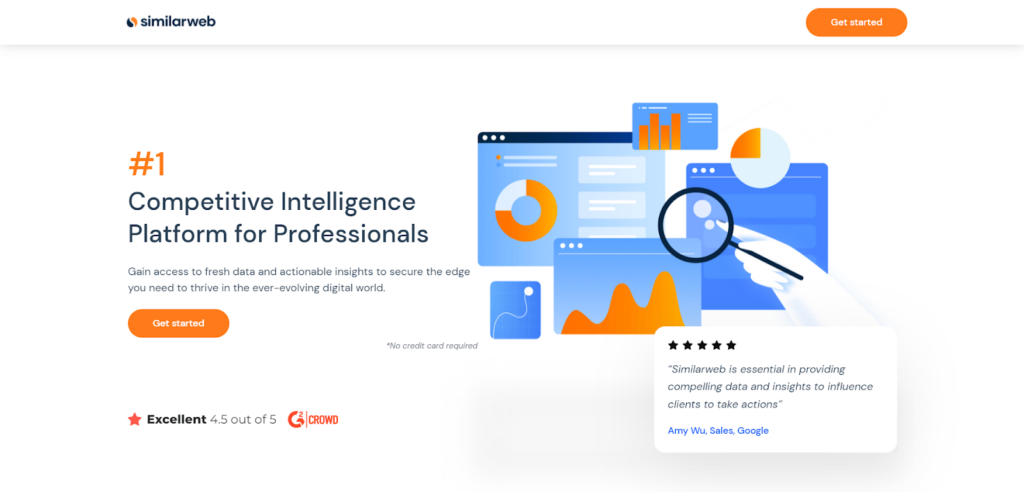
Founded in 2007 and headquartered in New York City, SimilarWeb is a top-notch SEO and digital marketing tool that offers various features and services, such as conducting keyword research, organic traffic analytics, competitive analysis, target audience demand, retail search and analysis, benchmarking, etc.
SimilarWeb is undoubtedly one of the most trusted SEO tools on the market, as it’s used by leading international companies such as Google, DHL, Booking.com, Adobe, and Pepsico.
| Tool | Prices start at | Free trial | Refund | Best for |
| Semrush (Pro plan) | $99.95 per month | 7-day free trial | 7-day money-back guarantee | Additional tools: social media, content research, marketing, etc. |
| SimilarWeb (Starter plan) | $167 per month | Limited free trial | No | Inorganic and organic keyword analytics |
What Does SimilarWeb Do Better?
Although the features that SimilarWeb offers are pretty similar to those provided by Semrush, there are several services and features that only SimilarWeb offers:
- Webpage analytics: SimilarWeb offers a deeper analysis of your website and extra information about the websites of your competitors, as well as the online sessions of their website audience. It provides both inorganic (paid) and organic keyword analytics.
- Free plan: Anyone can use SimilarWeb’s free plan. Although it offers limited features and services, such as five metric results, one month of data from mobile apps, and three months of web traffic data, it’s still 100% free.
- Free trial for students: If you’re a student, you can use SimilarWeb’s free trial and discover all its features and services by signing up and proving your student status.
- Custom pricing plan: SimilarWeb gives anyone an opportunity to ask for a custom pricing plan based on which features you’d like to use. On the other hand, Semrush offers this possibility only to enterprises.
What Does Semrush Do Better Than SimilarWeb?
Now let’s see the main advantages of Semrush over SimilarWeb:
- Integrations: Semrush offers a vast number of integrations with popular social media platforms, web builders, Google web services, etc. On the other hand, SimilarWeb offers only one integration — Google Analytics.
- Pricing plans: Apart from the limited free version provided by SimilarWeb, there are only two additional pricing plans — a custom pricing plan and one for small businesses, which costs $167 per month. Semrush offers a variety of pricing plans, and prices start at $99.95.
- Keyword filtering: With Semrush, you’ll get multiple options for keyword filtering and a Keyword Magic Tool.
- API access: With Semrush, you’ll get API access with any subscription plan, and with SimilarWeb, you need to pay an additional price.
- Refund: Unlike Semrush, which offers a 7-day money-back guarantee, SimilarWeb does not offer any kind of refund.
- Social Media tools: In addition to SEO and analytics tools, Semrush also has social media analysis tools, which ultimately makes it the winning tool compared to most SEO tools out there.
Semrush vs SpyFu

Founded in 2006 in Arizona, SpyFu is another SEO tool that’s used for competitor keyword research, pay-per-click (PPC) and competition analysis, custom reports, backlink outreach, SEO marketing analytics, etc.
Just as the name implies, this tool helps you keep a very close eye on the analytics and strategies of your paid and organic online competitors.
| Tool | Prices start at | Free trial | Refund | Best for |
| Semrush (Pro package) | $99.95 per month | 7-day free trial | 7-day money-back guarantee | Additional tools: social media, content research, marketing, etc. |
| SpyFu (Basic plan) | $39 per month | No | 30-day money-back guarantee | Inorganic and organic keyword analytics |
What Does SpyFu Do Better?
Let’s find out what are the main advantages of SpyFu vs. Semrush:
- Pricing: The main advantage that SpyFu has over Semrush is the pricing — prices start at $16 with the starter plan. However, keep in mind that the billing is on an annual basis. If you’d like to pay monthly, it’ll cost you $39, which is still a lot less than Semrush’s starter plan.
- Refund: With SpyFu, you get a 30-day money-back guarantee, and with Semrush, you’ll get a 7-day refund.
- Search results: With the Professional and Team plan, you’ll get an unlimited number of search results.
- Keywords for rank tracking: Even with its starter plan, SpyFu offers more rank tracker keywords (5000) on a weekly basis compared to Semrush, which offers 500 monthly.
- Interface design: SpyFu undoubtedly has one of the easiest interface designs that you’ll learn how to navigate pretty quickly, making it the perfect option for beginners.
What Does SEMrush Do Better Than SpyFu?
These are Semrush’s advantages over SpyFu:
- Traffic Analysis: Semrush has a unique tool for traffic analytics for how much traffic your website is getting, and SpyFu doesn’t offer that kind of tool.
- Additional tools: Unlike SpyFu, Semrush offers a lot more tools, such as social media content research analysis, online marketing, etc.
- Advanced reporting: With Semrush, you can customize your reports and even schedule reports beforehand.
- Keyword Magic Tool: Semrush’s tool for keyword research is invincible when compared to any other keyword tool, thanks to its vast amount of metrics and analytics, which can help you improve your website’s organic traffic.
- Additional SEO features: Unlike SpyFu, Semrush offers a broader range of SEO features and tools, such as backlink analysis, a site audit tool, a SERP tracking tool, etc.
- Free trial: Semrush has a 7-day free trial, unlike SpyFu, which doesn’t offer a free trial.
Semrush Case Studies
There are many unique case studies you can read about on Semrush’s blog and find out how the tool successfully helped businesses improve their SEO strategy, online presence in search engine results pages, and marketing strategies. Each client had different things that needed improvement with the tools provided by Semrush.
For example, Semrush’s SEO agency partner Re:signal, helped Learning with Experts, an international classroom community increase its organic traffic by 59.5%. With the help of Semrush, Re:signal focused on three different aspects:
- Identifying various keywords possibilities by analyzing competitor standings and estimated traffic with Keyword Gap tool
- Tweaking specific category pages with SEO Content Template tool
- Creating brand-new blog posts with SEO Content Template tool
- Discovering new potential ways to improve the overall website’s accessibility and health with the help of Semrush’s on-page SEO checker tool
Another interesting case study is the one involving the international SEO agency Why SEO serious, which helped Edelweiss Bakery, a small Florida-based bakery, increase their mobile organic traffic by an astonishing 460%.
Although Edelweiss Bakery has been around for more than 20 years, it was struggling to increase its online traffic. There were a few challenges that they were working with, such as a low percentage of orders and a lack of online branding or brand visibility.
The SEO agency highlighted three optimization steps to improve Edelweiss’ organic search traffic and accomplish the bakery’s main goals and objectives:
- Step one: SEO optimization, such as competitor analysis, discovering new opportunities for link-building, enhancing the website’s format and architecture, keyword research, SEO audit, broken links, links from referring domains and your website’s online presence etc.
- Step two: Optimization and creation of new SEO-friendly blog content, adding a new blog theme and content brief, conducting SEO audit for the blog content, etc.
- Step three: Creation of a brand-new e-commerce section and optimization, configuration of e-commerce analytics, etc.
With the help of Semrush’s features, after a 7-month period, the mobile organic traffic of Edelweiss Bakery has increased by approximately 460% (from about 171 visits to nearly 785 visits on a monthly basis).
Semrush Integrations
In addition to its many features and services, Semrush offers integrations with other popular platforms and tools. You only need an active platform and services account to connect it to your Semrush account.
Currently, Semrush offers integrations with social networks, Google, certain third-party partners, and more.
Social Networks
- Twitter: With the Social Media Tracker and Social Media Poster tools, you can track and schedule posts on Twitter and find out how they’re performing compared to your competitors.
- Facebook: By integrating Facebook with Semrush, you can track or schedule your posts from the Social Media Poster. With the help of the Social Media Tracker tool, you can easily track how your page is advancing and moving ahead compared to the pages of your competitors.
- LinkedIn: Using the Social Media Poster tool, you can schedule LinkedIn posts beforehand. If you’re an admin of a business page on LinkedIn, you can also use the Social Media Tracker tool and connect it to your business page. It will help you track the percentage of posts reached on LinkedIn.
- Pinterest: You can schedule pins on Pinterest with Social Media Poster and track the number of engagements compared to your competitors with the help of Social Media Tracker.
- YouTube: If you want to follow the engagement on your YouTube channel, you can connect your channel with Semrush and use the Social Media Tracker.
- Instagram: You can also use the Social Media Tracker and Social Media Poster tools if you’re running a business profile on Instagram.
- Google Search Console: 7 Google Search Console integrations can help you analyze data straight from Semrush’s interface.
- Google Business Profile: Using 5 widgets, you can add local data to Semrush’s My Reports.
- Google Ads: There’s no option to connect Google Ads with Semrush like you can connect Google Search Console or Analytics. However, you can import an existing Google Ad Campaign and upload any modifications you’ll make to Google Ads.
- Google Docs: You can connect and use Semrush’s SEO Writing Assistant whenever you use Google Docs and evaluate your texts while writing.
- Google Analytics: 10 Google Analytics integrations can help you analyze and monitor all the data available on your website directly from Semrush’s interface.
- Gmail Account: You can use your Gmail account and send e-mails if you connect your Gmail inbox to Semrush’s Backlink Audit and Link Building Tool.
- Google Search: Semrush has a free plugin called SEOquake that you can use to evaluate metrics from search results on Google. Moreover, SEOquake can also be used with two other web browsers — Opera and Mozilla Firefox.
- Google Sheets: You can export and see keyword or domain reports in Google Sheets.
- Looker Studio: You can import and see the data from Position Tracking report, Domain Analytics, or Site Audit in just a few clicks to your Looker Studio.
- Google Tag Manager: Using the primary tag of the AI tool known as ImpactHero, you can send all sorts of events that you’d like to be tracked directly from your site. Then, the events will be sent to the tool.
- Google Calendar: You can integrate Marketing Calendar to export campaign plans which can later be uploaded to your calendar. You can also integrate Content Audit and use it to create new tasks, which you can later send to Trello or your calendar.
Semrush’s Partners
- AIOSEO: All in One SEO, or AIOSEO, is a WordPress plugin used by more than 3 million website users to gain higher keyword rankings in SERPs.
- PageCloud: You can integrate PageCloud, a website builder that you can use to customize your own website and optimize it directly from Semrush. The best thing about PageCloud is its drag & drop editor that’s super easy to use — you won’t need coding knowledge to use it.
- Renderforest: This multi-purpose integration will help you use Semrush’s popular Keyword Magic Tool whenever possible. With Renderforest, you can manage, modify and customize your website and create mockups, logos, animations, etc.
- monday.com: Monday.com is an project management and business operating system you can use via Semrush. It helps you get keyword insights, manage projects, build workflows, manage your SEO content, etc.
- Scalenut: Scalenut is an AI tool used for writing. You can integrate it with Semrush and use it whenever you want to create SEO-friendly content for your website or research keyword and topics.
- Wix: Known for being one of the most popular website builders for startups and solo website owners, Wix and Semrush integration can help you set up SEO content and optimize your website precisely for your target audience.
- Quickblog: One of the best cloud-based applications for agencies, businesses, and solo SEO content creators, Quickblog and Semrush integration lets you use all the data from keyword research in order to discover brand-new vital SEO statistics that can help you enhance your organic traffic.
- SurferSEO: SurferSEO is another AI tool similar to Scalenut. It’s the perfect tool for SEO research, optimization, writing, audit, and creation of SEO content that can improve your overall organic traffic and brand. Since Semrush is integrated with the tool Grow Flow by SurferSEO, you can use it by connecting your SurferSEO account to Semrush.
Additional Integrations
- Trello: You can integrate Semrush’s Content Audit, Site Audit, Topic Research the On-Page SEO Checker tool into your Trello account and use it to gather insight from Semrush and transform it into actual work plans in Trello.
- Zapier: By integrating Zapier with Semrush’s Site Audit, you can create work tasks in Monday, Jira, or Asana or even send leads to Hubspot or Salesforce.
- WordPress: To use Semrush’s SEO Writing Assistant tool on your WordPress account, all you have to do is connect your account. Then, you can start using it to evaluate your SEO content in WordPress.
- Majestic: Majestic is a link-building and SEO backlink checker that can be integrated into Semrush’s Backlink Audit tool. After connecting your Majestic account to your Semrush account, you can pull data from Majestic and use it to import backlinks for auditing.
Semrush Certification and Training
In addition to offering unique features and services, Semrush has its own subsidiary academy and certification program that’s free of charge. The academy offers more than 30 courses and several video series that you can follow from anywhere worldwide at any given time.
The courses and videos have been created by highly skilled professionals in various fields, such as:
- SEO methods, technical SEO, on-page SEO, broken link building, link authority, and link building,
- Keyword research,
- Pay-per-click (PPC),
- Digital marketing,
- Advanced content marketing,
- Digital PR,
- Link building techniques skyscraper, lead magnets, guest blogging and so on,
- Tips on how to use Semrush tools and features,
- Tips on using AI writers for copywriting,
- Etc.
Once you finish a lesson, you will receive a badge. Also, you can take an exam any time — you don’t necessarily need to finish a course to get to the exam. You need to answer at least 70% of the questions correctly. If you do that successfully, you’ll get a certificate for free.
Wrap Up
After extensive testing and daily use in my SEO work, I can confidently say that Semrush lives up to its reputation as a top-tier SEO tool. Is it the absolute best? That depends on your specific needs, but it’s certainly among the elite options available.
Semrush has earned its place at the forefront of SEO tools. With 21 international awards and adoption by nearly a third of Fortune 500 companies, it’s clear that industry professionals trust and rely on its capabilities. In my experience, these accolades are well-deserved.
What sets Semrush apart is its comprehensive approach to SEO. It’s not just a keyword research tool – it’s a complete digital marketing suite. I’ve found its competitor analysis features particularly valuable, often uncovering opportunities I might have otherwise missed. The backlink evaluation tool has helped me identify high-quality link-building prospects, significantly improving my clients’ link profiles.
The social media tools have streamlined my workflow, allowing me to manage multiple aspects of digital marketing from a single platform. Website audits have been instrumental in quickly identifying and resolving technical SEO issues, saving hours of manual checks.
However, it’s important to address the elephant in the room – the price. Semrush isn’t cheap, and that’s a legitimate concern for many users, especially small businesses or solo entrepreneurs. In my opinion, the value it provides justifies the cost for most serious SEO professionals or businesses heavily invested in their online presence. I’ve seen firsthand how the insights gained from Semrush can lead to substantial improvements in search rankings and organic traffic, often more than offsetting the subscription cost.
For those on a tight budget, consider starting with a shorter subscription or sharing the cost with colleagues. You might find that the efficiency gains and improved results make it a worthwhile investment.
My advice? Take advantage of the seven-day free trial. It’s ample time to explore the features and see how they align with your needs. In my case, I was sold within days, discovering keyword opportunities and content gaps that immediately improved my SEO strategy.
Ultimately, while Semrush comes at a premium, its comprehensive toolset and reliable data make it an invaluable asset for anyone serious about improving their search engine visibility. Whether it’s the right choice for you depends on your specific needs and budget, but in my professional experience, it’s an investment that pays dividends in the competitive world of SEO.

